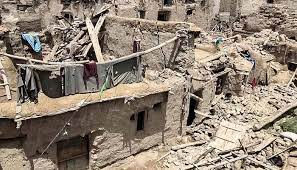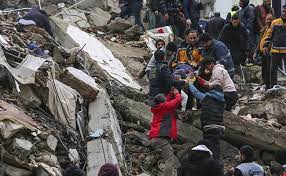Cultural capital of Afghanistan Earthquake hits the nation
 HEART: (Afghanistan) The death count from a magnitude 6.3 earthquake in western Afghanistan on Saturday has risen to “about 120″, disaster relief authorities said, with more than 1,000 others being treated for injuries.The United States Geological Survey said the epicenter was 40 kilometers (25 miles) northwest of the region’s largest city Herat, and was followed by eight aftershocks with magnitudes between 4.3 and 6.3.”So far, more than 1,000 injured women, children, and old citizens have been included in our records, and about 120 people have lost their lives,” Herat province disaster management head Mosa Ashari told AFP.
HEART: (Afghanistan) The death count from a magnitude 6.3 earthquake in western Afghanistan on Saturday has risen to “about 120″, disaster relief authorities said, with more than 1,000 others being treated for injuries.The United States Geological Survey said the epicenter was 40 kilometers (25 miles) northwest of the region’s largest city Herat, and was followed by eight aftershocks with magnitudes between 4.3 and 6.3.”So far, more than 1,000 injured women, children, and old citizens have been included in our records, and about 120 people have lost their lives,” Herat province disaster management head Mosa Ashari told AFP.
“We were in our offices and suddenly the building started shaking. Wall plasters started to fall down and the walls got cracks, some walls and parts of the building collapsed.” Herat resident Bashir Ahmad told the AFP news agency.”I am not able to contact my family, network connections are disconnected. I am too worried and scared, it was horrifying,” he added. More than 70 injured people were being treated at the city’s main hospital, a health official said.
Crowds of residents fled buildings in Herat at around 11:00 am (0630 GMT) as the quakes began.”We were in our offices and suddenly the building started shaking,” 45-year-old resident Bashir Ahmad told AFP.”Wall plasters started to fall down and the walls got cracks, some walls and parts of the building collapsed,” he said.”I am not able to contact my family, network connections are disconnected. I am too worried and scared, it was horrifying.”
Men, women and children stood out in the wide streets, away from tall buildings, in the moments after the first quake and remained wary of returning to their homes as aftershocks rumbled for hours. “The situation was very horrible, I have never experienced such a thing,” said 21-year-old student Idrees Arsala, the last to safely evacuate his classroom as the quakes began. Early on Saturday evening, disaster management authority spokesman Mullah Jan Sayeq told AFP that the number of fatalities was expected “to rise very high”.”There are some areas that are totally collapsed and all the houses are damaged,” he said. “People are still buried under the rubble. The aid agencies are trying to reach the area.”
Hundreds of fatalities were possible, according to a USGS preliminary estimate. “Significant casualties are likely and the disaster is potentially widespread. Past events with this alert level have required a regional or national level response,” it said.
The USGS had earlier reported the first quake’s magnitude as 6.2. It had a shallow depth of just 14 kilometers, it said.Herat — 120 kilometers east of the border with Iran — is considered the cultural capital of Afghanistan. It is the capital of Herat province, which is home to an estimated population of 1.9 million, according to 2019 World Bank data. Afghanistan is frequently hit by earthquakes, especially in the Hindu Kush mountain range, which lies near the junction of the Eurasian and Indian tectonic plates.
In June last year, more than 1,000 people were killed and tens of thousands left homeless after a 5.9-magnitude quake — the deadliest in Afghanistan in nearly a quarter of a century — struck the impoverished province of Paktika.In March of this year, 13 people were killed in Afghanistan and Pakistan by a magnitude 6.5 quake, which hit near Jurm in northeastern Afghanistan. Afghanistan is already in the grip of a grinding humanitarian crisis, following the widespread withdrawal of foreign aid since the Taliban returned to power in 20Jjjjjjjjjjjjjj
The US Geological Survey said the 6.3 magnitude earthquake struck about 40km from the western city of Herat, close to the border with Iran, at around 11:00 local time (06:30 GMT).A number of buildings were damaged, trapping people under rubble, Afghan officials said.
“The situation was very horrible, I have never experienced such a thing,” student Idrees Arsala – the last to safely evacuate his classroom after the quakes began – told AFP.
Herat is located 120km east of the border with Iran and is considered to be the cultural capital of Afghanistan. An estimated 1.9 million people are believed to be living in the province, according to 2019 World Bank data.The country is frequently hit by earthquakes – especially in the Hindu Kush mountain range as it lies near the junction of the Eurasian and Indian tectonic plates.
In June last year, the province of Paktika was hit by a 5.9 magnitude quake which killed more than 1,000 people and left tens of thousands homeless.(Bureau Report with Media Inputs).

